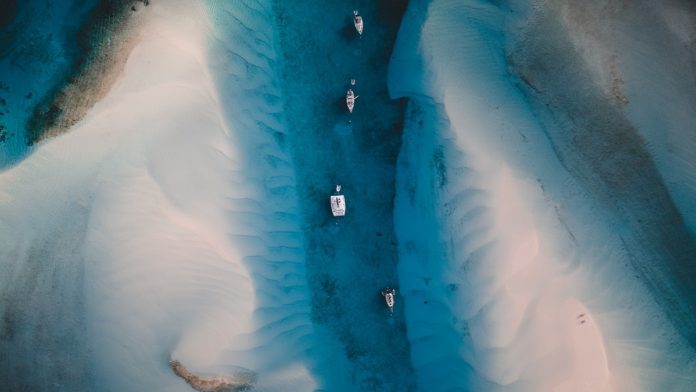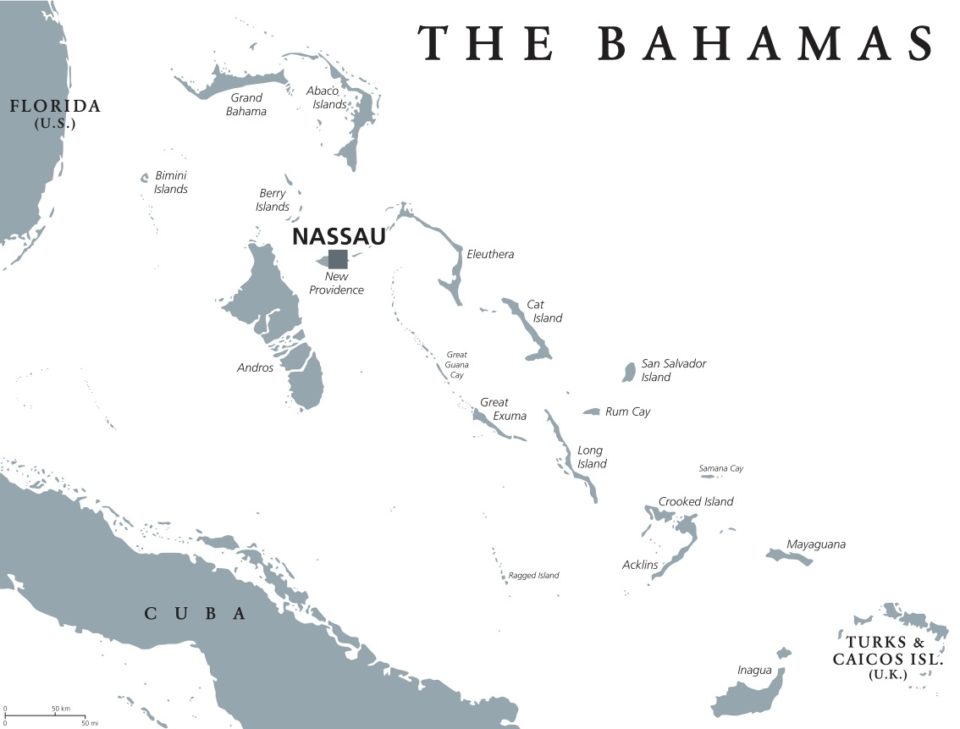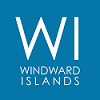
Lying as little as fifty miles from the Florida coast, the Bahamas are a tantalizing offshore destination for boaters and sailors. With over 700 islands and 2,400 cays and islets scattered over 150,000 square miles of crystal clear water, the Bahamas is a perfect playground for limitless exploration and recreation.
The thirty populated islands feature resorts, restaurants, gorgeous beaches, and many sights to see. Whether you’re looking for a posh resort or a private corner away from it all for a Bahamas Yacht Charter, you’ll find miles of white sand beaches and coral reefs in this sprawling paradise.
The Bahamas is also a popular starting point for boats headed to a Caribbean Yacht Charter via the Thorny Path, an island-hopping route from Florida all the way to the Dominican Republic, Puerto Rico, and the Virgin Islands.
The distance to sail between Florida and the Bahamas

Depending on where you leave from and where you sail to, the distance varies from fifty nautical miles (nm) to about 100 nm. Those are distances to the westernmost ports, so may opt to sail a little further in before making landfall and clearing into the country. It’s not a long sail, but it is an offshore sail, and needs to be taken seriously.
Most departures to the Bahamas are between Port St. Lucie and Miami, and head to Grand Bahama (Freeport and Port Lucaya), Bimini, the Abacos, Nassau or the Andros. It’s not uncommon to clear into one of the more western islands before proceeding further into the archipelago.
Depending on the speed of your boat, where you leave from and where you’re headed, this trip can range from a few hours for fast power cruisers up to a full day and overnight for slower sailboats.
Use our Sailing Distance calculator
The best time of the year to sail from Florida to the Bahamas
The winter months are the most popular time of year to sail to the Bahamas. Hurricane risks end in early November, and the winter is cooler with less rain. Though hurricanes are possible in the summer, the odds of getting caught in one are low, though you should always keep a sharp eye on the weather in season.
Bahamas Weather
Winter in the Bahamas is lovely, with average temperatures of 70-75ºF. The trade winds are almost constant, keeping away stifling heat in the summer months, where the temperature averages 80-85ºF. You should have a light jacket in case of a cool breezy evening in the winter months, but most days are light clothes weather.
Wind in the Bahamas
The trade winds dominate wind patterns in the Bahamas, and sailors can be guaranteed of near constant easterlies. In the winter, the trades tend more northeasterly, and in the summer they come more from the southeast. Average wind strengths are five to twenty knots most of the time.
What are the dangers of sailing from Florida to the Bahamas?
The trip out to the Bahamas isn’t long, but it’s a sail across open, deep ocean with serious wind and currents. Storms are possible, and poor conditions can develop even on a brief trip. It’s important to pay close attention to wind and weather patterns, and pick a favorable window to cross. The Gulf Stream is the prime consideration for course routing and weather windows.
Negotiating the Gulf Stream
The Gulf Stream is a North-flowing current between the coast of Florida and the Bahamas. There is no way to avoid sailing through it. If you pick a good day, it’s just pretty water that pushes you off course. But if you pick poor wind conditions, it can be one of the worst ocean passages you’ll experience.
You’ll know you’re in the Gulf Stream by an increase in water temperature, and sometimes by a startling change in color to a deep, cobalt blue, and by wildlife. You’ll also start seeing sideslip on your GPS track.
Adjusting for Current
The average current across the Gulf Stream is about 3.5 knots (4 miles per hour), strongest in the center, and tapering off towards the boundaries. Off Florida, it may be thirty or forty miles across. For every hour you spend in the Gulf Stream, your boat will be swept 3.5 miles off course to the north. It’s critical to plot a course-to-steer route that accounts for the current, or you will end up sailing extra distance.
An aggressive “stay on course” navigation will ensure you arrive where you’re intending, but it will not be the fastest, most effective course to sail. This also works better for faster power boats. Current will sweep low sailboats much further north.
Do not cross with Northerly winds
When northerly winds blow into a southerly current (which flows to the north…), the result is waves. Big, steep waves. In the Gulf Stream, a day of hard breeze from the north can build up steep waves and truly nasty and dangerous conditions.
So check the weather, and if northerly winds are blowing over 15 knots, do not leave for a day or two.
Read also: What is a bareboat charter?
Hurricane risk isn’t null
Hurricane season runs from June through November in the north Atlantic, so any time you sail in that wind there is a slight chance of a hurricane developing while you are en route to the Bahamas or cruising the islands. The islands in the Bahamas are low-lying, with little protection and few good “hurricane holes” if a storm develops.
The chances of a hurricane strike are quite low, but you should be prepared. As you sail deeper into the islands, keep a plan of what you will do if a hurricane forms, and where you will go to avoid it or secure the boat to ride it out.
Even outside hurricane seasons, storms can sweep through the Bahamas and make the trip treacherous, so always mind the weather.
On this subject: Hurricane season in the BVI: what you should know
What yacht do you need to sail safely from Florida to the Bahamas?
The sail across to the Bahamas is quite short, and with pleasant weather it’s a not a hard trip which many small boats have made. But the boat should be seaworthy with protection from ocean spray and waves. Low-sided or open boats with little freeboard are not good choices since they may swamp, so most “day boats” like small dinghies and skiffs are not safe.
Sailboats and catamarans should have some shelter and protection, and a place to store enough food and water for the trip. Powerboats need a reliable engine, and a hull designed for offshore waters. Remember, the smaller the boat, the longer the trip will be, so make sure you have plenty of supplies.
Read also: The 5 best sailing boats under 60 feet
A shallow draft is better for cruising much the Bahamas, because there are many flats and shallows. Sailboats with drafts over six feet may want to reconsider, and the lower the draft, the easier.
What are the common routes and starting points?
Your choice of where to leave from affects where you want to sail, and it may be better to pick a better starting place by the destination. If you’re headed to Grand Bahama Island or the Abacos, a northern departure is better, but Bimini, Andros and Nassau most leave from further south.
Rather than sail a course from the north that takes you into the teeth of the Gulf Stream current and across the Little Bahama Bank, most choose to sail south along the coast to a departure point where they can wait for a weather window for the shortest time in the Gulf Stream.
Miami
Miami is the easiest jumping off point for Bimini and on to Andros or Nassau. The initial distance is short, less than fifty nautical miles, and can be an easy day trip for some.
Fort Lauderdale
Only twenty miles north of Miami, Port Everglades is another popular jumping-off point for Bimini and beyond. It adds about five miles to the distance, making it over fifty nautical miles with a little more time in the Gulf Stream.
Palm Beach
If you’re headed to Grand Bahama, Palm Beach is a better starting point. It’s not quite seventy-five miles to Freeport, and a few miles past that to Port Lucaya. Palm Beach is about sixty miles north of Miami.
Stuart/Port St. Lucie
The St. Lucie inlet is about as far north as you may want to start your way to the Bahamas. It’s closer to ninety nautical miles, but still a pleasant sail.
Clearing In and Formalities
When you enter the Bahamas, you’ll need to clear in with customs and immigration as soon as you arrive. Use their Click2Clear website to pre-register for a mandatory cruising permit, and contact Customs and Immigration at the port of entry where you arrive. Check the Noonsite country page for the Bahamas more details.
Chartering a yacht to sail the Bahamas
Chartering a boat from the coast of Florida to sail to the Bahamas is a great opportunity for real sailing experience on an extended tropical vacation. Power and sail charters are available at any of the starting ports, though Miami to Bimini may be easiest for a first-timer.
Plan to spend at least a week on your charter, but the Bahamas are so expansive you’ll probably want more time. Make sure you leave enough time to wait for a weather window at the end. While there are worse places to be “stuck” waiting for a northerly wind to clear than the Bahamas, you don’t want pressure to sailing into something you shouldn’t.
For more details read the cost of chartering a yacht and the common pricelist for yacht charters in the Caribbean.
The Bahamas Loves Cruisers
Cruisers love the Bahamas because you can sail there from the U.S. so easily, and because the islands are so wide and varied with so much to explore. The beauty is unsurpassed, and you can spend months hopping from island to island and port to port. But the people and government of the Bahamas also love you to come visit, and they make it an amazing boat destination. So plan your trip, pick your weather window, and head out!
Read also: Top 3 Luxury Yachts of the Week in the bahamas

